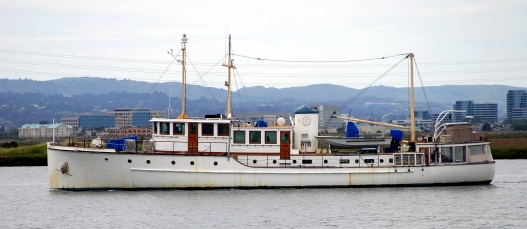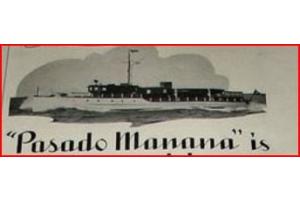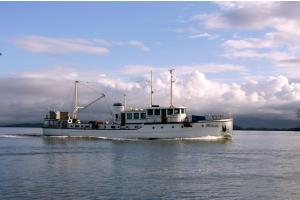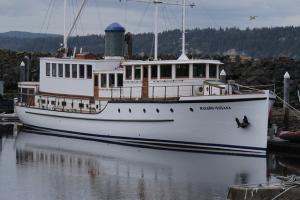Historical Summary:
Excerpt from "Bay Belle Retires; Catamaran Carries On", by Joe Eaton.
Polaris was custom-built for attorney and financier Lee Allen Phillips in 1927, originally christened Pasado Mañana (“Get Around to It Tomorrow”). The Wilmington Boat Works used oak timbers, Douglas-fir planking, teak for the decks, mahogany finish for the cabins. As executive vice president of Pacific Mutual Life Insurance, Phillips had a hand in the construction of the Biltmore Hotel in Los Angeles, and the draining of the Cienega wetlands. As president of California Delta Farms, he oversaw the conversion of over 100,000 Delta acres to agriculture, including the Jones and Rindge Tracts and King, Bacon, and Bouldin Islands, collaborating with George Shima, a Japanese immigrant known as the Potato King. Much of the acreage was leased to Chinese- and Japanese-born farmers. Phillips took the Pasado Mañana into the Delta to inspect his properties and on duck-hunting trips, and to sea after marlin and swordfish off Catalina Island. She was also a “floating hotel” for visiting VIPs like Winston Churchill and Herbert Hoover.
After Phillips’ death in 1938, his widow sold Pasado Mañana to oil executive John Grant. The Army acquired the vessel during World War II to move troops around Puget Sound. A postwar owner, Alaska Charters, rechristened her Polaris before selling her to Ken Bechtel in 1959. Bechtel donated her to the University of California. Byron Richards, her long-time skipper with USGS, was told that every time she left UC’s Richmond berth, “something broke.” In 1966 UC sold the vessel to the USGS for $4000, and she became part of the agency’s Pacific-Alaska Marine Geology Program.
Polaris took her first Bay cruise in the late 1970s, initially for marine geologist David McCulloch’s seismic studies, then branching into water quality work.“ It’s amazing how little we knew about the Bay in the late 60s,” says biologist James Cloern, who heads the USGS water quality sampling program. “Fundamental discoveries were made from the Polaris that couldn’t be made any other way; some were used to shape environmental policies.” Aboard the Polaris, young oceanographers from the University of Washington–John Conomos, Fred Nichols, Bill Broenkow, and Dave Peterson–launched the modern era of Bay science.
There were questions about the condition and health of the Bay that not everyone wanted answered. Officials in Sacramento tried to shut the nascent program down; one reportedly cautioned that water was a political issue, not a scientific one. Some federal agencies were also hostile. “They warned us against pursuing the research, threatened our jobs,” recalls Conomos, now retired. USGS director William Pecora was not intimidated. “Our agency didn’t back down,” says Conomos. “They supported us completely and we kept our funding.”
Early on, Polaris had some old-school skippers who didn’t always see eye-to-eye with the scientists. Then Byron Richards, who grew up on the Bay (“My younger brother and I lived on the water”) and graduated from the California Maritime Academy, got the job in 1980. “Byron was a gift from God, the heart and soul of Polaris and the field data collection program,” says Conomos. Cloern calls him “a treasure to work with.” For Tara Schraga, lead scientist for the water-quality cruises, Richards was “a stellar captain who cared deeply about the program, always fixing, fabricating, and making sure we got the science done.” Richards insists Polaris engineers Jim Robello and Scott Conard deserve credit for the program’s success as well.
Richards found “a lot of stuff jury-rigged,” he recalls. He helped put Polaris to rights and restored something of her former glory, stripping 13 coats of paint from the salon, down to the original mahogany: “The Army had painted it white; later somebody painted it baby-shit yellow, then green like the cells in San Quentin.” He discovered a unique prohibition-era feature in the mid-80s: two copper tanks behind a false bulkhead in the main cabin. Chris Morrison, Phillip’s grandson, confirmed that there had been spigots on the after bulkhead for the cocktail hour. “He said Phillips loved his Scotch,” Richards recalls. There’s a family legend of whiskey from Canada being dumped overboard to avoid a run-in with the US Coast Guard.
Polaris has carried generations of scientists. David Schoellhamer, a sediment specialist, visited her “as a little kid” when his father Jack managed the marine geology program. Cloern first saw her on a PBS “Nova” episode when he was in graduate school. “I thought, ‘What a great job,’” he remembers. “Six months later I was working with the USGS scientists.” He and others later brought their own PhD candidates and post-docs on board.
The cruising routine evolved as new equipment became available. Leaving Redwood City, Polaris would visit 36 stations along an 80-nautical-mile transect from Alviso to Rio Vista to sample water quality, at first with a sump pump to on-board instruments, later with sophisticated conductivity, temperature, and depth sensors dropped over the side. A new group of scientists would come aboard at Rio Vista and collect clams and other benthic organisms from the mud on the return voyage. A 17-foot Boston Whaler was deployed for shallow-water work. Sometimes Polaris returned to her first owner’s old Delta stomping grounds, up the Sacramento and Cosumnes rivers.
The data they collected was used to shape the X2 standard (for an indicator of the North Bay’s salinity gradient) and California’s marine invasive species act, and will influence the pending chlorophyll standard. “Measurements before and after urban sewage treatment programs were in place document successes of the Clean Water Act,” says Cloern. “From Polaris data, we’ve learned a lot about how invasive species like the Asian clam have affected San Francisco Bay, and how oscillations of climate systems have caused big changes in the Bay’s biological community.”
“This may be the longest-running continuous monitoring program in the US,” Schraga says. “This incredible time-series data reveals drivers of change in the Bay, from human impacts to climate change. It’s a national treasure.” “Every single data point we’ve ever collected is available online,” Cloern adds. “The site gets half a million users a year from 73 different countries.”
It wasn’t all routine sampling. Francis Parchaso (photo above), who runs the benthic sampling program, remembers a squall in San Pablo Bay with wind-driven waves breaking over the boat, and being stuck on a sandbar in Three Mile Slough waiting for a tidal assist. Schraga recalls dodging floating trees during the 1998 El Niño. The Polaris, for all her splendid qualities, had a tendency to roll. Leaving Redwood City, Richards once warned: “If there’s anything you don’t want, leave it on the counter.” But on the whole she was undaunted by bad weather. “Being long and narrow, she could slice right through the wind and waves,” says Parchaso.
Polaris’ original engine was replaced with an Oakland-made direct reversible Union Diesel engine in 1959. By all accounts, it was a cranky beast. At one point the boat nearly hit a drawbridge in the Oakland Estuary after the engine conked out. Richards lost power on another occasion coming into Redwood City. “We dropped anchor, and it was like anchoring in Anderson’s Pea Soup,” he recalls. “We were drifting sideways, a hundred feet out from the pier.” Out of options, he grabbed a heavy line, jumped off the bow, swam to the dock, hauled the line in. Conard then secured her to the pier. “Next day, “ Richards recalls, “John Conomos brought me a bottle of twelve-year-old Scotch and said, ‘Never do that again.’ ” Not long afterward, a new engine was installed and the Union Diesel was donated to the San Francisco Maritime National Historic Park’s museum.
After 29 years as master of Polaris, Richards retired in 2009, and Joel Fritsch, another Maritime Academy graduate, took the helm. He was accustomed to huge dredge ships: “She handled a lot differently from what I was used to. She was built for luxury, not for maneuverability.” He did his best to keep her floating but “water was coming in at all the seams.” Polaris made her last cruise in May 2015 as the oldest working vessel in federal service.






 This is an archived vessel, and is not currently registered with the CYA. If you are the vessel owner, please
This is an archived vessel, and is not currently registered with the CYA. If you are the vessel owner, please